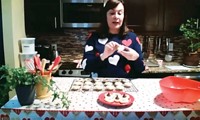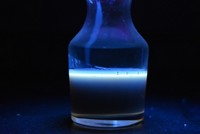Advertisement
Grab your lab coat. Let's get started
Welcome!
Welcome!
Create an account below to get 6 C&EN articles per month, receive newsletters and more - all free.
It seems this is your first time logging in online. Please enter the following information to continue.
As an ACS member you automatically get access to this site. All we need is few more details to create your reading experience.
Not you? Sign in with a different account.
Not you? Sign in with a different account.
ERROR 1
ERROR 1
ERROR 2
ERROR 2
ERROR 2
ERROR 2
ERROR 2
Password and Confirm password must match.
If you have an ACS member number, please enter it here so we can link this account to your membership. (optional)
ERROR 2
ACS values your privacy. By submitting your information, you are gaining access to C&EN and subscribing to our weekly newsletter. We use the information you provide to make your reading experience better, and we will never sell your data to third party members.
Education
Newscripts
Thanksgiving dinner chemistry, Seasoned ammunition
by Linda Wang
November 20, 2006
| A version of this story appeared in
Volume 84, Issue 47
Thanksgiving dinner chemistry

When Thanksgiving rolls around, most college students are ready for a break. That's why College of Wooster, Ohio, chemistry professors Judy Amburgey-Peters and Paul Bonvallet will forgo their usual organic CHEMISTRY LECTURES and talk instead about the chemistry of Thanksgiving dinner.
"By the time you get to that Monday before Thanksgiving, we're tired, too, and this gives us a chance to have fun," Amburgey-Peters says. The chemistry professors cooked up the idea earlier this year after brainstorming ways to help their students relate the chemistry they learn in class to their everyday lives.
"You go home from college, and the whole family wants to know, 'So, what are you doing in school?'" Amburgey-Peters says. This allows for some interesting Thanksgiving table conversation, she says.
On the menu is turkey, bread in a basket, cranberry sauce, and pumpkin pie. Turkey, says Amburgey-Peters, contains tryptophan, an amino acid that the students recently studied. The professors will discuss the stereochemistry of the amino acid and touch on its purported sleep-inducing effects.
The atoms in starch are identical to those in cellulose; so why is it that you can eat bread but not the basket? "One of the key differences is a single type of bond that connects the sugar unit," Amburgey-Peters says. "One is more reactive than the other." She adds that our bodies have an enzyme that can break down starch, whereas we don't have enzymes that can break down cellulose.
Dish up some cranberry sauce, and you dish up tons of antioxidants, Amburgey-Peters says. The students will learn that antioxidants scavenge damaging free radicals, which they learned about in an earlier lesson. In addition, cranberry seeds contain essential fatty acids, which also have health benefits.
And finally, pumpkin pie and sweet potato pie, in fact anything with color, contain conjugated double bonds. Amburgey-Peters says the students will learn about the reactivity of alkenes in a later class. Pumpkins and sweet potatoes also contain beta carotene, which is the precursor for vitamin A.
"It'll be interesting, when they get back on that Monday after Thanksgiving, to hear what kinds of conversations went on at the dinner table," Amburgey-Peters says.
Seasoned ammunition

There may be a new way to season that turkey. A company called Season Shot has developed a biodegradable, FLAVORED AMMUNITION that will season a bird from the inside out. Brett Holm, a carpenter from Chaska, Minn., and cofounder of Season Shot, came up with the idea in 2005 after watching a friend struggle to remove steel shots from a game bird the friend was preparing for dinner.
According to the company's website, www.seasonshot.com, the ammunition is made of tightly packed seasoning that's injected into the bird on impact. When the bird is cooked, the seasoning pellets melt into the meat, spreading the flavor to the entire bird. Bloggers are buzzing about the product, and the company's website says Season Shot is "coming soon" in these flavors: cajun, lemon pepper, garlic, teriyaki, and honey mustard.
A request to the company for more information was not immediately returned. Perhaps the product is not out of the woods yet, but the Newscripts gang is eagerly awaiting it.
This week's column was written by Linda Wang. Please send comments and suggestions to newscripts@acs.org.





Join the conversation
Contact the reporter
Submit a Letter to the Editor for publication
Engage with us on Twitter